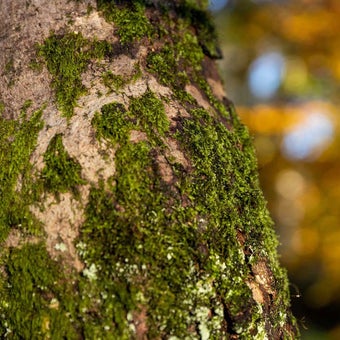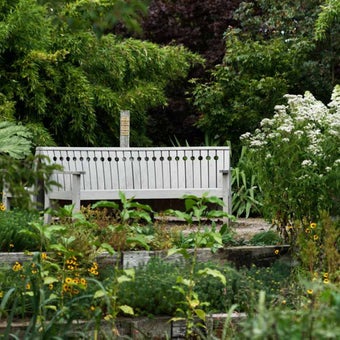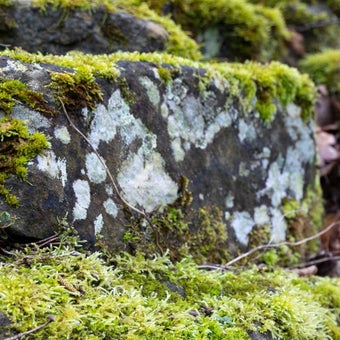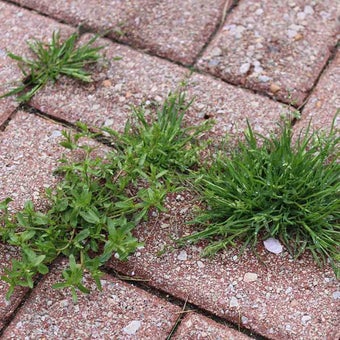
Quick facts
Algae, liverworts and mosses all require a moist environment to reproduce
Although small, they are an important part of garden ecosystems, providing habitat and food for many creatures
They can make surfaces slippery, so should be controlled in areas where they might cause slips and falls
There are simple, non-chemical ways to discourage algae, lichens, liverworts and mosses growing where they are not wanted
Algae and algae-like growths on hard surfaces
Algae don’t have true roots, stems or leaves, and just form a thin layer on top of hard surfaces. A green film or powdery deposit is typical of algae on stone, paving, tarmac, concrete and decking. Algae thrive in wet conditions, and growth may be faster in shady areas with poor air circulation. Build-ups often occur after wet winters.
Algae-like Nostoc can also grow on paths and driveways, especially on compacted gravel. Nostoc forms greenish-brown, jelly-like growths when wet, which become dark and crusty when they dry out.

Lichens on hard surfaces
Lichens are common on paving and stone walls and structures; they form thin, flat crusts, or flat, creeping growths with leaf-like lobes. Even paths and paving in dry and bright conditions can be colonised by flat, crust-like lichens, these are likely to be almost white in colour.
On timber structures, such as garden benches, you might see lichens with tufted, bushy growth. They can be silver-grey, grey-green, yellow or orange.

Did you know?
Several lichens, including Protoparmeliopsis muralis, are often mistaken for old patches of chewing gum when seen on pavements.
Liverworts on hard surfaces
Liverworts that grow on hard surfaces tend to produce green, flattened, plate-like growth. A common example is Marchantia polymorpha; it produces umbrella-like reproductive structures. Liverworts thrive in damp, shady areas.

Mosses on hard surfaces
Compact, green, cushion-like mosses are commonly found on paths, patios and decking. Green and yellowish mosses growing in carpets or tufts may also be seen on stone and wood. Creeping mosses with a low branching habit often appear on the edges of hard surfaces, spreading in from neighbouring surfaces. Many mosses favour damp, shady conditions.

Did you know?
The UK is rich in native species of algae, lichens, liverworts and mosses. The UK’s number of native moss species is over half that of Europe’s; by comparison, the UK has less than one tenth of Europe’s number of native tree species.
See our guide to Algae, lichens, liverworts and mosses for more information on these fascinating organisms and where else in your garden you might find them growing. For information on using mosses in gardens, see our page on the Magic of Moss.
Do I need to get rid of algae, lichens, liverworts and mosses from hard surfaces?
Not necessarily – they do not damage the surfaces they grow on and allowing them to grow:
- Boosts the of your garden – even a small patch on a hard surface can support many species of algae, lichens, liverworts and mosses. Rare species of lichens have been found growing in gardens in rural areas.
- Provides food and habitats for garden wildlife – they offer shelter to small creatures, including beetles, spiders, springtails and woodlice, and even smaller microscopic invertebrates such as rotifers, tardigrades and nematodes. Mosses are used by garden birds as nesting material and are a food source for many moths.
- Adds character – algae, lichens, liverworts and mosses create a sense of maturity and permanence within gardens. They help blend harsh stonework into the surrounding environment. Growths can form attractive and interesting tapestries, adding colour and texture to hard surfaces.
Where growths of algae, lichens, liverworts and mosses present no hazard, such as on stone sculptures and features, gardeners are encouraged to allow them to flourish. However, their presence can make hard surfaces slippery, so as a safety measure, it is advisable to prevent or manage their growth on surfaces that are walked on.
How do I control algae, lichens, liverworts and mosses on hard surfaces?
If you have algae, lichens, liverworts and mosses growing in areas where they might cause slips and falls, there are several ways to remove and control them:
Remove existing growths
- Brush hard surfaces with a stiff broom or wire brush to remove established growths. Brushing on a regular basis helps to prevent growths from taking hold.
- Use a pointed weeding tool, or old knife, to remove mosses from the cracks between paving.
- Use a pressure washer to remove growths quickly. However, use this method with care in areas where drainage is unsatisfactory as the extra water could exacerbate damp problems. Bear in mind a lot of water and energy will be used for just a temporary solution, as growths will return if conditions remain the same. Always wear goggles when using a pressure washer.


Discourage further growths
- Rake loose surfaces, such as gravel, regularly to prevent algae, Nostoc, liverworts and mosses growing.
- Prune overhanging plants to reduce shading and improve air flow; this allows the drying effects of sun and wind to reach the area.
- Ensure surfaces slope slightly to prevent standing water. Paths that are raised above surrounding ground are ideal, as this allows water to run off into adjacent borders.
- Improve drainage in the surrounding area to help deter growths. Dig out shallow channels along the edges of paths, patios and drives and fill with coarse gravel to absorb run-off water.
- Reduce compaction by lightly forking over beds close to hard surfaces to maximise drainage and water absorption in the area.
- Limit paving to areas essential for access. Choose permeable paving when constructing new hard surfaces.
- Keep drains clear of leaves and debris to allow rainwater to drain away quickly.
- Improve the grip of hard surfaces. Lay and tack down chicken wire on wooden surfaces to make them less slippery.
Should I use chemical controls?
As non-chemical control methods are effective, there is no need to use mosskillers or chemical patio cleaners. Most products are non-persistent and repeat applications will be required. Growths of algae, lichens, liverworts and mosses will return to an area if the growing conditions remain unchanged.
However, we do note that when gardeners struggle to control growths with cultural methods, products for home gardeners are available for use legally. Garden centres and large retailers have trained staff who can advise on suitable products for your needs.

















